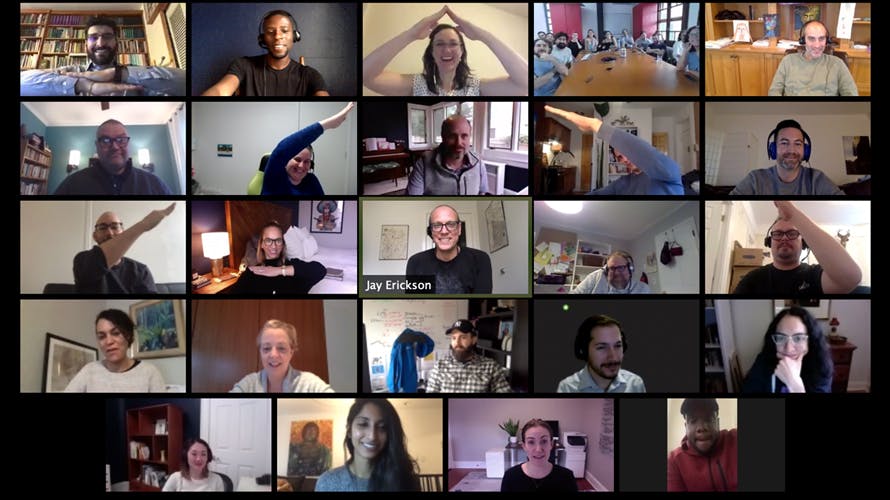Remote Innovation: Collaboration and Creativity in the Time of Coronavirus

Use this time to reinvent how you do what you do, bring consumers new alternatives, new value, and in the process even reinvent your own brand. Don’t let innovation stop, because this could be the window of opportunity.” –Doug Stephens, Futurist
In just a few short months, coronavirus has changed everything. Including how we work. The internet is now flooded with tips and tricks for remote work — how to stay productive while working at home (thank you Deep Focus playlist on Spotify), how to set up your work space so you don’t get a stiff neck (90/90 people), how to host an engaging Zoom meeting (embrace the icebreaker), and on, and on.
Most of us have been initially focused on continuity plans for our bread-and-butter operations. But what about innovation? Can we still collaborate to create new ideas effectively? Should companies continue to invest in out-of-the-box thinking and initiatives? The answer is absolutely, yes and yes.
There are certainly aspects of innovation that are just plain work and can follow the continuity path of standard operations — emails and phone calls, assignments and deadlines, etc. But there are key ingredients for a good innovation soup that can appear harder to cultivate in this environment, and I want to focus on two: creative mindset and collaboration.
Creative mindset
Being in the right state of mind is critical for early ideation and knowing when and how to pivot an idea. We usually try to step away from the hyper-rational modality of day-to-day business, tamp down the executive function areas of the brain, roll down the windows and amplify the intuitive centers. We often accomplish this by a combination of getting offsite, an inspiring talk, field visits/shadowing, or special exercises that get the juices flowing. Some of these approaches are not viable in the current environment but certainly activities like word associations, doodling, meditation, viewing an inspiring TED talk, or even dancing are feasible in the age of COVID.
We are all in a unique moment where our daily routines have been broken and are being reformulated and we are being forced to reinvent the way we conduct a lot of our business. It is challenging, to say the least, but it also fosters an inherently creative mindset.
In this upside-down world, we may be able to see problems or projects with the elusive but powerful beginner’s mind or shoshin that allows us to shed burdensome preconceptions and biases — creating space for new ideas and approaches. It also feels like in this moment there is a willingness on the part of others to entertain a much broader range of conversations and concepts.
All of that being said, it can be hard to manage general anxiety in this environment and, as we know, fear is the mind killer. So make sure to exercise, go for walks, meditate, or whatever it is you do to stay grounded — because it will help you be more creative.
Remote collaboration
At Modus we love a good workshop, and we have traditionally favored conducting them in person. Working together with a bunch of cross-disciplinary folks in a room for an afternoon or a couple days solving problems and coming up with novel ideas is one of my favorite parts of the job. But now that it is dangerous (and illegal) to congregate for non-essential purposes, how can we replicate the experience remotely? Here are a few tips and tricks:
- Invest in a quality remote platform and learn it well. Personally, I prefer Zoom because of its stability, ubiquitousness, and powerful feature set. Regardless of your platform, the facilitator should be an expert at using it and troubleshooting any issues in real time. If necessary, have someone from IT attend the workshop to assist and encourage participants to download any software and check their sounds and webcams (and backgrounds…) at least half an hour before the start.
- Build on existing agendas. What you did in real life (#irl) still makes sense remotely, and design thinking is still design thinking. So don’t throw out the playbook, just adjust for the new medium.
- Create space for socializing. What doesn’t happen remotely as naturally is the important social collision that takes place around the water cooler, in hallways, break rooms and during happy hours. Maybe start the day with a breakfast and ask everyone to just sit together, shoot the breeze, sip coffee, and eat their home-baked scones for 30 mins before things “get started.” You might try random pairings for social video hangs (we call this “donut time” at Modus). Or a just good ol’ virtual happy hour at the end of the day.
- Breakout meetings and solo time. Zoom has a great feature to seamlessly spin up break-out rooms just as you would do in a physical space. But even if your platform doesn’t have that feature, you can pair people up to connect via FaceTime, Skype or whatever medium makes sense and then return to the group. Also allow for solo ideation, sketching time where people stay on the virtual hangout but mute and do work on their own before rejoining the group and sharing.
- Make sure there is ample time for breaks. In a physical meeting room people regularly get up, stretch, and move around. But on a video call people feel less comfortable leaving the frame, or may be constrained by a headset. Plus it’s important for us all to maintain good #selfcare and go for a walk in the yard or do some quick stretching. You may consider group stretches (especially in the mid-afternoon / post-lunch doldrums).
- Use the platform for fun. Make sure there are moments of levity throughout the day by sharing some funny memes that may be relevant to your company or project, use icebreakers, or play with virtual backgrounds.
- Integrate disparate physical spaces. While we may all be working virtually, we are all still (I think?) in the physical world. Set up moments or exercises for individuals to share their physical space through “MTV Cribs”-style tours, sharing favorite views or objects, introducing pets or kids, or a quick walk in the backyard. In some ways, this brave new world may afford opportunities for us to get to know each other better than ever despite the distancing.
Why should we lean in to remote innovation now?
Remote work is here to stay, at least for the foreseeable future for many industries — and even long term, the fabric of work will change. Commuting is different — people won’t be hopping planes to jump from NYC to SF, DC to Chicago. Not only is travel dangerous during the age of COVID but, in a post-pandemic world, travel still takes a toll on the environment and climate.
And innovation should not and cannot stop if your business is going to be successful. Not only to avoid missing longer-term trends a la Kodak or Blockbuster, but because the world has changed overnight — and will never be the same. This moment could be an asteroid for your business and the choice may be to innovate or go the way of the dinosaurs.
Modus is here to help: organize a remote innovation workshop or reach out for help or advice with your innovation soup and we can work through this unprecedented time together.



